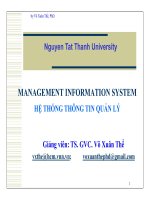Management information system ralp 7e ch06
Bạn đang xem bản rút gọn của tài liệu. Xem và tải ngay bản đầy đủ của tài liệu tại đây (1.44 MB, 49 trang )
• Effective communications are essential to organizational
success
• Define the terms communications and telecommunications
and describe the components of a telecommunications
system
Principles of Information Systems, Seventh Edition
2
• An unmistakable trend of communications technology is
that more people are able to send and receive all forms of
information over greater distances at a faster rate
• Identify broad categories of communications media and
discuss the basic characteristics of specific media types
• Describe how a modem works
• Explain the types of telecommunications carriers today and
the services they provide
Principles of Information Systems, Seventh Edition
3
• Identify the benefits associated with a telecommunications
network
• Define the term network topology and identify five
alternatives
• Discuss the different communications protocols and
devices used for telecommunications
• Name three distributed processing alternatives and discuss
their basic features
• List some telecommunications applications that
organizations are benefiting from today
Principles of Information Systems, Seventh Edition
4
An Overview Of Communications
Systems
• Communications: the transmission of a signal by way of
a medium from a sender to a receiver
• Signal contains a message composed of data and
information
• In telecommunications, sender transmits a signal through
a transmission medium such as a cable
Principles of Information Systems, Seventh Edition
5
Figure 6.2: Communications and
Telecommunications
Principles of Information Systems, Seventh Edition
6
An Overview Of Communications
Systems (continued)
• Communications can be synchronous or asynchronous
• Synchronous communications: the receiver gets the
message instantaneously
• Asynchronous communications: the receiver gets the
message some period of time after it is sent
Principles of Information Systems, Seventh Edition
7
Telecommunications
• Telecommunications: electronic transmission of signals
for communications, via telephone, radio, television, etc.
• Data communications: subset of telecommunications that
refers to the electronic collection, processing, and
distribution of data, typically between computer system
hardware devices
• Telecommunications medium: anything that carries an
electronic signal and interfaces between a sending device
and a receiving device
Principles of Information Systems, Seventh Edition
8
Figure 6.3: Elements of a
Telecommunications System
Principles of Information Systems, Seventh Edition
9
Communications Channels: Basic
Communications Channel
Characteristics
• Communication channels can be classified as simplex,
half-duplex, or full-duplex
• Simplex channel: can transmit data in only one direction
• Half-duplex channel: can transmit data in either direction,
but not simultaneously
• Full-duplex channel: permits data transmission in both
directions at the same time
Principles of Information Systems, Seventh Edition
10
Channel Bandwidth and InformationCarrying Capacity
• Bandwidth: the range of frequencies that an electronic
signal occupies on a given transmission medium
• Shannon’s fundamental law of information theory:
states that the information-carrying capacity of a channel
is directly proportional to its bandwidth
• Broadband: telecommunications in which a wide band
of frequencies is available to transmit information
Principles of Information Systems, Seventh Edition
11
Types of Media
• Guided transmission media: communications signals are
guided along a solid medium
• Wireless media: communications signals are sent over
airwaves
Principles of Information Systems, Seventh Edition
12
Table 6.1: Transmission Media Types
Principles of Information Systems, Seventh Edition
13
Table 6.1: Transmission Media Types
(continued)
Principles of Information Systems, Seventh Edition
14
Modems
• A typical telephone line can only accommodate an analog
signal (a continuous, curving signal)
• A computer generates a digital signal representing bits
• Modem: a device that translates data from digital to
analog and analog to digital
Principles of Information Systems, Seventh Edition
15
Figure 6.8: How a Modem Works
Principles of Information Systems, Seventh Edition
16
Multiplexers
• Multiplexers: devices that allow several
telecommunications signals to be transmitted over a
single communications medium at the same time
Principles of Information Systems, Seventh Edition
17
Figure 6.9: Use of a Multiplexer to
Consolidate Data Communications onto
a Single Communications Link
Principles of Information Systems, Seventh Edition
18
Front-End Processors
• Front-end processors: special-purpose computers that
manage communications to and from a computer system
• Connect a midrange or mainframe computer to hundreds
or thousands of communications lines
Principles of Information Systems, Seventh Edition
19
Figure 6.10: Front-End Processor
Principles of Information Systems, Seventh Edition
20
Carriers and Services
• Local exchange carrier (LEC): a public telephone
company in the United States that provides service to
homes and businesses within its defined geographical area
• Competitive local exchange carrier (CLEC): a company
that is allowed to compete with the LECs, such as a
wireless, satellite, or cable service provider
• Long-distance carrier: a traditional long-distance phone
provider, such as AT&T, Sprint, or MCI
Principles of Information Systems, Seventh Edition
21
Switched and Dedicated Lines
• Switched line: a communications line that uses switching
equipment to allow one transmission device to be
connected to other transmission devices
• Dedicated line: a communications line that provides a
constant connection between two points; also called a
leased line
Principles of Information Systems, Seventh Edition
22
Voice and Data Convergence
• Voice over Internet protocol (VoIP): the basic transport
of voice in the form of a data packet using the Internet
protocol
• IP telephony is the technology for transmitting voice
communications over a network using an open standardsbased Internet protocol
• Voice and data convergence: the integration of voice
and data applications in a common environment
Principles of Information Systems, Seventh Edition
23
WATS
• Wide-area telephone service (WATS): a fixed-rate longdistance telecommunications service for heavy users of
voice services
• IN-WATS service
• OUT-WATS service
Principles of Information Systems, Seventh Edition
24
ISDN
• Integrated services digital network (ISDN): a set of
standards for integrating voice and data communications
onto a single line via digital transmission over copper wire
or other media
• ISDN requires special adapters at both ends of the
transmission line
• ISDN Basic Rate Interface
• ISDN Primary Rate Interface
Principles of Information Systems, Seventh Edition
25









